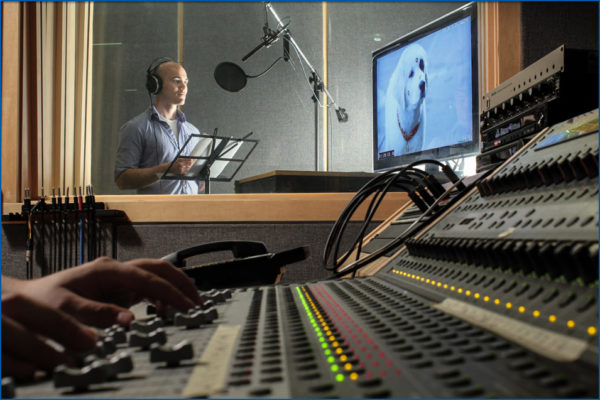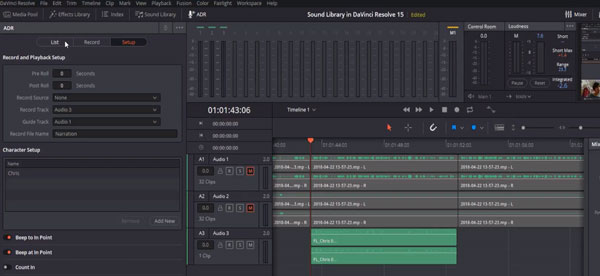ADR (Automated Dialogue Replacement) – What Is It & How To Do It With No Budget
What is ADR (Automated Dialogue Replacement)?
In film or video, if an actor speaks their dialogue is usually recorded while filming. This dialogue audio is then used during the edit and sound mixing process so the audience can hear what the actor is saying (hopefully).
But the audio can’t always be recorded at a good enough quality, for a variety of reasons. Perhaps a key take had an airplane going overhead and you didn’t have time to retake it. Or an air conditioning unit is humming away in the background.
Maybe you turn up to film and the building across the road is being rebuilt and at the same time your sound recordist runs off with the audio files and refuses to give them to you unless you pay him lots of money.
That last example actually happened to us while filming our sci-fi web series.
If you find yourself with unusable dialogue audio (or in our case, none at all) you will probably have to replace that audio somehow. That process is called ADR.
To add to that story, our lead actor was from the USA (we shot in London). So he had to fly home and we had no budget to fly him back for ADR. Luckily he was a musician with his own home studio. So he improvised his own ADR.
What is ADR in the film industry?
If you have the budget, you would schedule all the actors whose dialogue needs replacing to visit an ADR studio – a recording studio specialised in and set up for ADR work.
If you think that having to replace dialogue in your film means you’ve been unprofessional and failed in some way, think again. Most big budget films use ADR, to some degree or other.
One of our cast in that sci-fi show, Virginia Hey, was a main character in a hit show called Farscape. And she told us that the whole first season had to be done with ADR. As they didn’t have the budget to create a sound proof stage, they filmed in a big warehouse which was pretty noisy.

Here’s some reasons why dialogue might get replaced:
- Noisy or unclear audio was recorded on set.
- Replacing or adding lines to enhance the performance.
- Fixing accents.
- Fixing story or continuity errors.
- Loop group/secondary characters – adding life to crowd scenes or groups of characters.
- TV/Airline versions.
- Sound-alike for an unavailable actor.
Improvising a low budget ADR setup
Hiring an ADR studio is going to be beyond the budget of most micro-budget filmmakers. But the audio for your movie can make or break it’s success. You’ve spent weeks, months or years on this project – are you going to let the audio ruin your hard work?
When we did the ADR for our show, I had access to a small recording studio (since I used to be a professional composer). I then used Apple’s Logic Pro (which we used for composing so we didn’t have to buy it).
I achieved this by uploading the video clip which contained the poor (or missing) audio. Luckily we had the audio from the inbuilt mic of the camera to give us a guide. In Logic Pro, I set the program to record in a loop until I hit stop.
The actor would then attempt to deliver the dialogue as accurately as possible. After a few tries (like 4 or 5) we would stop and listen, checking to see how well it matched the lips and the emotion. Most important is that the new dialogue matches the timing of the lips. And of course that the emotion is as good (or better) than the original.
Once we were happy, we would move onto the next clip. What I found was that some actors struggled and others were astonishingly good at it. Terry Molloy nailed his dialogue in tone and timing almost in the first attempt of every line. Terry does a lot of radio work, so perhaps this experienced helped.
Hey, the free version of DaVinci Resolve has an ADR setup included
DaVinci Resolve is one of the best industry standard editing and colour correction platforms. And there’s a free version.
In the “fairlight” tab, you’ll find the ADR window.

Using DaVinci Resolve’s dedicated ADR setup will be a lot easier than trying to work around Log Pro, which is designed for writing music.
Included in Resolve are things such as a count in and beeps which help the actor know when to start talking.
If you are already using Resolve to edit, then using it to do ADR saves time moving files around, too.
DaVinci Resolve fairlight Official Website link.
Low budget ADR tips
We’ve seen the pictures of these plush sound-proofed studios capable of recording perfectly clear and crisp, reflectionless audio. So we should attempt something similar, but improvised. This was also my thinking when we did the ADR for the sci-fi show.
The problem is that perfect, crisp dialogue sounds unnatural when you place it in the scene – especially if you mixing it with other dialogue recorded on set. Why? Because in any interior location, there will be reflections on the audio.
For big productions, they process this clean dialogue afterwards, adding the appropriate reflections (or reverb). This helps it sit into the scene and makes it sound as if were recorded there. As it happens, this is actually quite difficult and time-consuming.
Use the same or similar location. One time and money saving option then is to (as close as possible) record the ADR in the same space in which you filmed. Either that, or in a space similar to the scene you are working on.
Now you won’t have to spend hours trying to make your reflectionless ADR dialogue match the other non-ADR dialogue.
This is more practical for interiors than exteriors. Note that usually when recording audio outside there are much less reflections. So the audio comes out sounding similar to recording in a booth.
Microphone placement. The proximity of the mic to the actor changes the tone and texture of the dialogue audio. If the non-ADR audio was captured using a shotgun mic and the ADR is captured using a studio mic with the actor standing closer, the audio won’t match as well.
Try using the same mics for the ADR – and at the same distance – as were used when recording the scene on location.
You can edit the audio. If the new replacement dialogue doesn’t quite match the timing of the lips, there’s a couple of things you can do. One is to go in and try to cut little bits out of the audio to get the timing in place. This is quite fiddly and time consuming but can work quite well.
Don’t show the actor’s lips. If your replacement audio doesn’t match the original timing, you can try cutting away to something else to cover it. If the conversation is between 2 or more actors you don’t always want to be looking the person speaking anyway.
You can cut away to the listener reacting, close ups of hands or some other interesting visual. Don’t worry, everyone will just think your masterful vision motivated the cut to a close up of a spoon slowly stirring a cup of tea. In fact, it’s because the dialogue went out of sync. But it’s win-win – because the dialogue now fits and you’re hailed a genius…
Work on the performance. ADR is hard and the actor can find the whole process a bit robotic. It’s important to remind the actor they are free to experiment. Ask them to play around with it to loosen things up.
Recording ADR is less of a pressured situation than on set, when time is more limited and there’s more things to get right. With ADR you just need one thing – great audio sound and performance. So you can afford to spend time getting it right.
That’s my tips on how to get the best ADR with limited resources. If you find it helpful, you might want to subscribe below for more articles on low budget filmmaking and equipment.
Eager to learn more?
Join our weekly newsletter featuring inspiring stories, no-budget filmmaking tips and comprehensive equipment reviews to help you turn your film projects into reality!
Simon Horrocks
Simon Horrocks is a screenwriter & filmmaker. His debut feature THIRD CONTACT was shot on a consumer camcorder and premiered at the BFI IMAX in 2013. His shot-on-smartphones sci-fi series SILENT EYE featured on Amazon Prime. He now runs a popular Patreon page which offers online courses for beginners, customised tips and more: www.patreon.com/SilentEye

